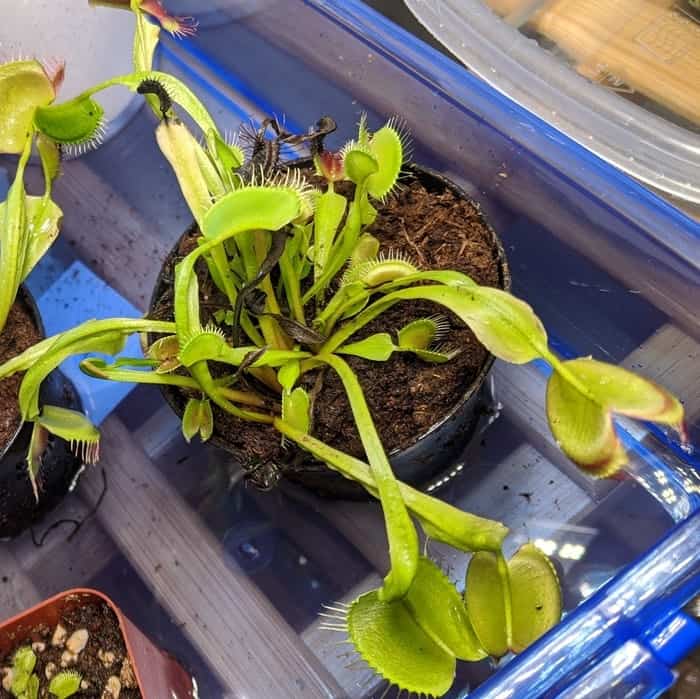In pictures, most Venus flytrap appear standing upwards, like chasing the sun. However, sometimes, Venus flytraps grow close to the ground or appear droopy. I have grown Venus flytraps for several years, and sometimes I buy plants that look droopy as I know it is just a quick fix. In this article, I will teach you some tricks to stop your plant’s wilting appearance.
Some Venus flytrap varieties tend to grow close to the ground; other Venus flytraps look droopy due to improper growing conditions. For example, plants that do not receive enough sunlight or water start wilting. Venus flytraps require plenty of sunlight and humid soil. Unsuitable growing conditions weaken the plant and endanger its health.
In this article, you will learn how much water and light Venus flytraps need. After implementing a few easy changes when caring for your plant, you will notice a considerable difference in their health.
Why Is My Venus Flytraps Not Standing Up?
In this section, you will determine why your Venus flytrap is looking down. Generally, there are two main reasons: nature or improper growing conditions.
Nature
Not all Venus flytraps stand up tall. Some varieties of Venus flytraps characterize by growing close to the ground. There is only one Venus flytrap specie. However, different variations of cultivars have been developed. Some varieties have unique characteristics such as vibrant colors, bigger traps, or wider petioles. It is common for some Venus flytraps to grow close to the ground and never stand up. Some people call these plants “ground huggers.” This behavior will not affect their health; they are still effective predators.
The picture below shows one of my Venus flytraps. The plant is healthy. It exhibits healthy colors, and it propagated multiple times last summer. As you can notice, the plant does not stand up. It takes a substantial horizontal area due to its growth pattern.
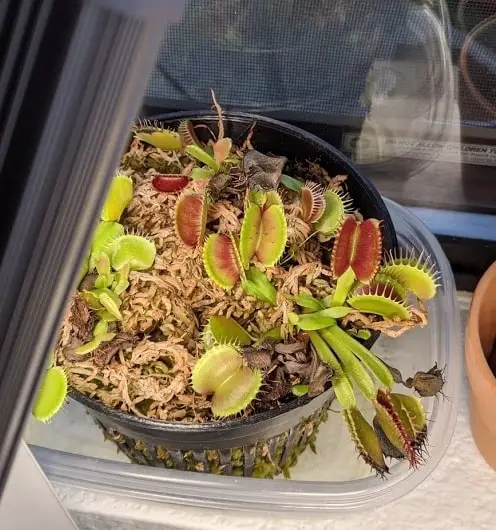
If you own one of those “ground hugger” Venus flytrap, do not worry. Not all Venus flytraps look the same. Still, to make sure your plant is healthy all around, make sure to download this free Venus flytrap care sheet. You can go over each item on the list and confirm you are providing a suitable home for your plant.
Improper Conditions
Sometimes Venus flytraps do not stand up due to improper growth conditions. For example, Venus flytraps are often left in store shelves for weeks before someone buys them. In those conditions, the plants do not receive any lighting or water for weeks.
There are 3 main reasons why a Venus flytrap is not standing up:
- Not enough water
- Improper lighting
- Unwanted stress
Venus flytraps require particular conditions to remain healthy. The three items in the list above are not exclusive. Those three factors, either separately or as a combination, can affect Venus flytraps and make them look droopy.
The two pictures below show the before and after of one for one of my Venus flytraps. I bought it in the gardening sections of a hardware store. The plant was still healthy, but the leaves were all droopy due to stress, lack of water, and lighting.
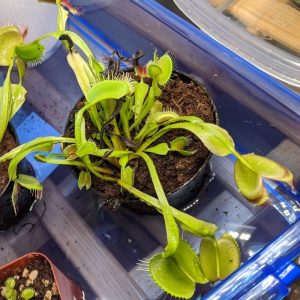
Before 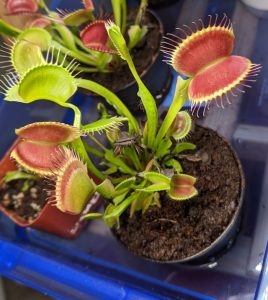
After
How to Fix a Droopy Venus Flytrap
When a Venus flytrap usually stands up, but suddenly is looking down, there are a few ways to resolve it. Make a few adjustments in the lighting, watering, and placement of your plant, and it will be standing up in no time.
Consistent Watering
Now, let’s learn how to water a Venus flytrap appropriately.
First, you can only water Venus flytraps with pure, nutrient-free water. Do not employ tap water or bottled water. Instead, use distilled water, rainwater, or reverse osmosis water. Venus flytraps are unable to process minerals or nutrients through their roots. The improper water source can kill them very quickly. In some places where tap water is pure, tap water might be suitable for Venus flytraps. Still, you will need to measure the number of Total Dissolves Solids (TDS) in the water with a TDS meter. A measurement below 50 ppm indicates an acceptable water source.
Venus flytraps require humid environments to thrive. The soil of the plant must always remain moist without exceptions. Venus flytraps suffer when the ground dries up. Water the plant often to keep the soil moist. But please, do not flood the ground (it shouldn’t look like mud or a swamp), but make sure it is watered all the way through. Press the soil with your finger to confirm it is humid. The tip of your fingers should feel the humidity in the ground without getting soaked.
After watering the soil, wait until it is less humid before watering. But do not let the potting media to dry up.
Some plants struggle when watered too often, and Venus flytraps are not an exception. Venus flytraps are prone to root rot when overwatered. Still, it is unlikely due to the plant’s high humidity requirements.
Not enough access to water can hurt Venus flytraps significantly. The plant won’t die instantly, but it will start to weaken, droop, and ultimately dry out. Dry soil is a big no-no for Venus flytraps and most carnivorous plants.
Water Tray Method
The water tray method ensures Venus flytraps are always watered the correct amount. Not too little and not too much. Follow these instructions:
- Find a shallow container to serve as a water tray. Preferably, choose a tray that is made up of plastic or glazed ceramic.
- Place your plant pot on top of the water tray.
- Fill out the water tray with distilled (or rain or reverse osmosis) water. The height of the water should be between half an inch to an inch.
- Let your plant absorb the water from the tray. The soil will remain moist, but not damped.
- After the tray dries out, refill it.
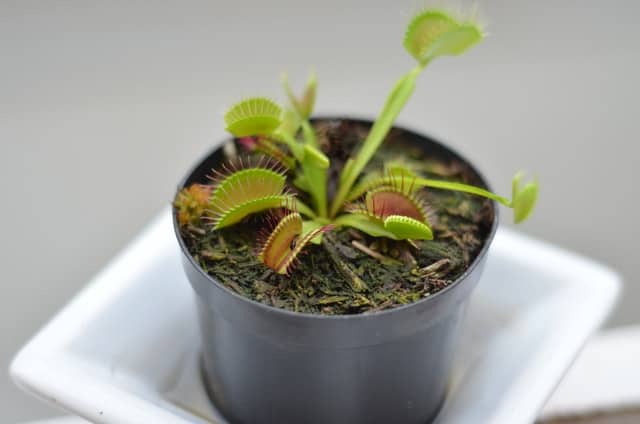
The water tray method is an effective alternative from only watering from the top. Watering from the bottom prevents overwatering and promotes root growth.
Proper Lighting
A Venus flytrap can start looking down or droopy when it does not receive enough light. Venus flytraps require many hours of sunlight to be healthy. Optimally, Venus flytraps should receive 12 hours of sunlight during the growing season. As a minimum, the plant must be exposed to at least six daily hours of light.
The easiest way to provide adequate lighting for your plant is to place them outdoors. Direct sunlight is optimal for Venus flytraps. Venus flytraps can also live healthy under indirect sunlight if they receive extended periods of light.
Venus flytraps are strong and resilient plants; they can withstand temperatures between 32 F to 95 F. Place your plant in a strategic location where they can receive enough sunlight but without the risk of burning or freezing solid.
It is also possible to provide appropriate lighting indoors. Sunny windowsills are perfect spots for Venus flytraps. They appreciate the light and might even capture some bugs when the windows are open. Besides natural lighting, artificial lighting is an alternative for indoor locations.
High output fluorescent lights or LEDs work well for Venus flytraps. For example, you can employ LED plant lights like this one to grow Venus flytraps. LEDs do not heat up, and they consume little electricity.
After exposing a Venus flytrap to adequate lighting, you will notice a big difference. The plant will stand up (if it usually does), the traps will exhibit bright red colors in the inside section of the lobes. And the traps will grow big and strong. Plants that suffer from light starvation are unable to develop large traps.
Unwanted Stress
Venus flytraps tend to droop or lose leaves when they undergo stress. For example, plants tend to look down for a few weeks after been shipped to a new location. Also, a change in its environment can produce stress.
Follow the advice below to avoid causing unnecessary stress to your plant:
- Do not play with the traps of the plant. The trapping mechanism is very complex. The plant spends a lot of energy controlling the traps, and generally, the plant must save as much energy as possible to focus on growing and developing.
- Avoid moving the plant to different locations. Venus flytraps prefer step by step transitions to new environments. Only move the plant when necessary.
- Keep curious beings such as cats or dogs away from the plant. The bright colors of the plant, together with interesting shapes, attract pets, which might not be very gentle.
Final Thoughts
A droopy Venus flytrap can be a warning sign of poor growing conditions. Still, if the plant is healthy in all other aspects, recovery will be quick. Focus on providing enough light and water to your plant. Also, avoid exerting unwanted stress. After only a couple of weeks under optimal growing conditions, the plant will recover.


